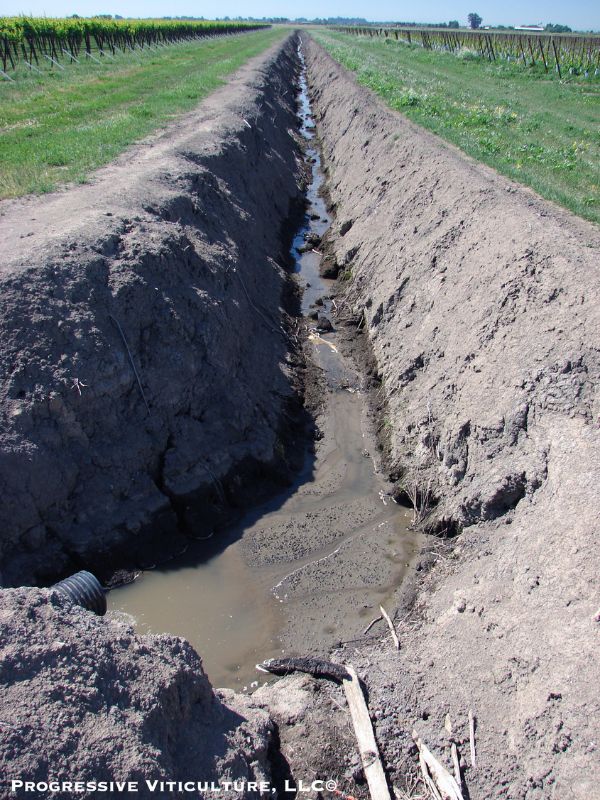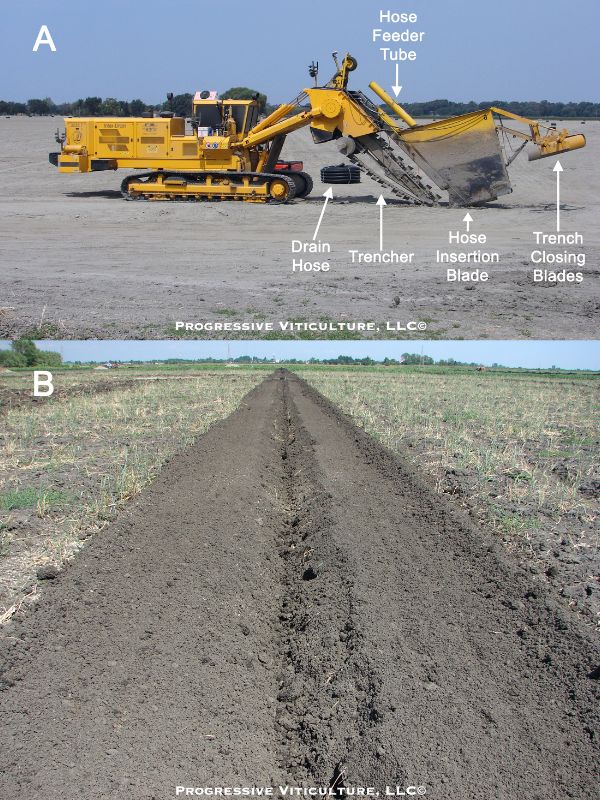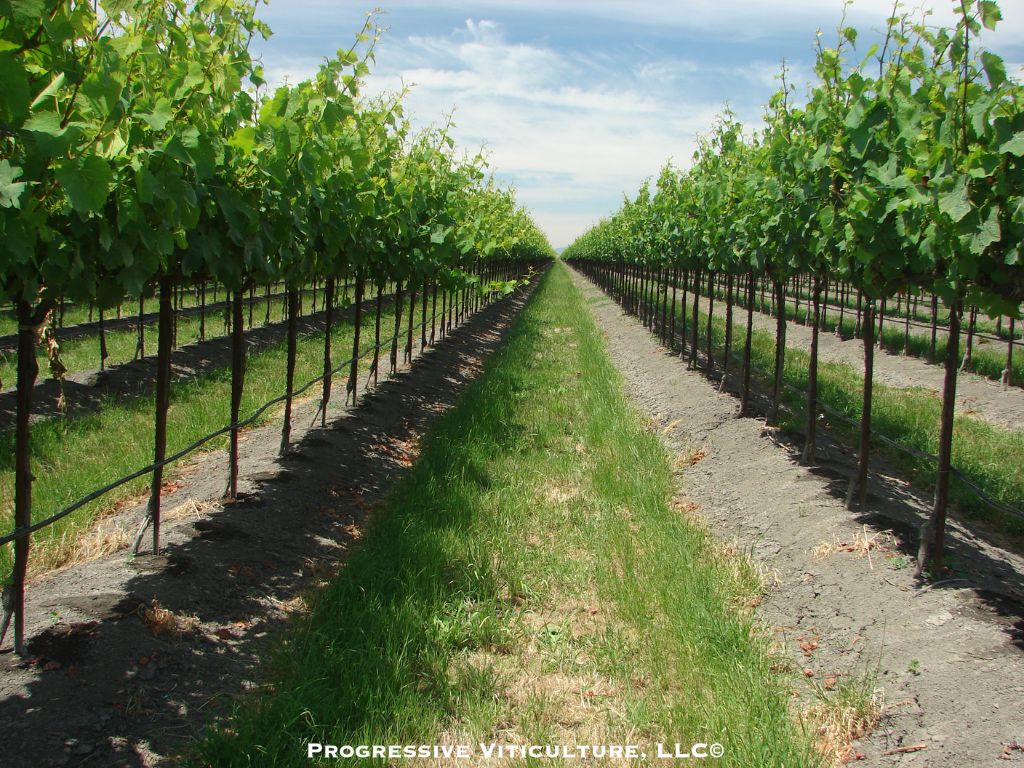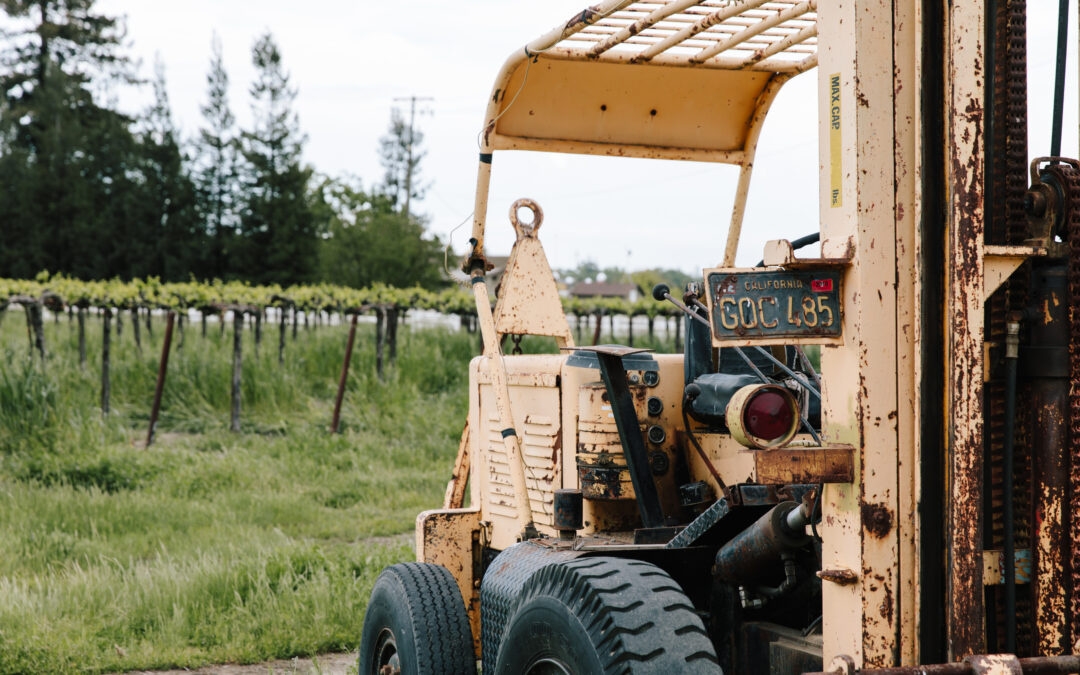MONDAY, APRIL 24, 2023. BY STAN GRANT, VITICULTURIST.
Continued from TOO MUCH WATER & NOT ENOUGH AIR: WATERLOGGED VINEYARD SOILS PT 1.
MANAGEMENT ACTIONS FOR EXCESSIVE SOIL MOISTURE – PREPLANT
As with most soil management goals, it is best to take steps to promote aeration before planting a vineyard. This includes actions to enhance water infiltration through soil surfaces, internal soil permeability to air and water, and subsurface drainage.
Preplant deep ripping or slip plowing is highly effective for disrupting and neutralizing hardpans and claypans, respectively, thereby assuring unrestricted subsurface drainage. Simultaneous deep incorporation of organic amendments further improves the permeability of most soils, while gypsum improves those containing excessive sodium and some with excessive magnesium. Deep cultivation also alleviates topsoil compaction.
Where high water tables persist into the growing season, peripheral ditches alone are sometimes sufficient to ensure adequate root zone drainage and aeration (Figure 1).

Figure 1. A high-capacity drainage ditch between two vineyards. (Photo source: Progressive Viticulture©)
This applies to some small vineyards, narrow vineyards, and vineyards where in-season water tables infrequently intrude into root zones. Pumping water out of ditches lowers the pressure within them, creating a pressure gradient that pulls water out of adjacent soils and draws air behind them through soil surfaces. Drain water is deposited into an empty channel or another watercourse.

Figure 2. (A) Mechanized equipment for tile drain installation (without front-mounted hose reel and gravel hopper) and (B) the closed trench following tile drain installation. (Photo source: Progressive Viticulture©)
In some cases, adequate root zone drainage and aeration requires tile drains spaced at appropriate depths and intervals across the vineyard. Early tile drain systems involved clay pipes, hence the name “tile” drains. Modern systems consist of fabric-covered perforated plastic pipe, at least 4 inches in diameter, enveloped in gravel (Figure 2). Tile drains function somewhat like underground ditches, using pumps to pull water from nearby soils into the pipes. The extent of vertical water drawdown increases as pipes are placed deeper and spaced closer together (Figure 3). Tile drains are usually the best option for draining root zones of water from artesian springs and water that collects in depressions within vineyards.

Figure 3. (A) A tile drain system cross-section, where the minimum depth of water table drawdown is a function of drainpipe depth and spacing, and (B) the discharge from an operating tile drain system. (Photo source: Progressive Viticulture©)
Wherever there is a risk of waterlogging, plant vines on berms. These narrow ridges centered under vine rows facilitate early soil warming and drainage. Further, berm soils are better aerated than the vineyard soils outside of them. As such, berms are favorable environments for the bases of vine trunks (crowns) and roots.
Select a rootstock known to impart some degree of tolerance of excess soil moisture to grapevines, such as Schwarzmann, 1616C, SO4, and Riparia Gloire. Conversely, avoid rootstocks considered low in tolerance to wet soils, including 99R, 140R, 101-14, and St. George.
MANAGEMENT ACTIONS FOR EXCESSIVE SOIL MOISTURE – POST PLANT
After planting, strive to maintain high root zone infiltration rates and permeability with cover crops, regular organic matter additions, periodic tillage, and, where appropriate, gypsum applications.
When root zones become saturated, take measures to minimize grapevine stress. Ensure drainage systems are operating to pull air or, at least, aerated water into and spent water out of root zones. Similarly, pump flood waters to ensure their continued movement and capacity for gas exchange.
Apply materials to grapevine foliage to compensate for compromised roots due to waterlogging. Where vineyards are inaccessible to tracklayer tractors and sprayers with flotation tires, utilize aerial applicators. Consider applications of readily assimilable nitrogen, phosphorus, potassium, and micronutrients, as well as the hormones cytokinins and gibberellins. In some instances, the combination of low biuret urea, dipotassium phosphate, a complete micronutrient fertilizer, and seaweed extracts rich in hormones has elicited positive responses from vines on waterlogged soils.
After the excess water has drained from formerly waterlogged soils, apply fertilizer to revitalize roots. Some fertilizers designed for this purpose contain a little ammonium nitrogen, abundant phosphorus, and stimulating materials, such as organic acids. Disrupted microbial activity and diminished mineral nutrient availability in recently waterlogged soils may increase the need for fertilizer applications during the remainder of the growing season.
After an extended period of waterlogging, apply liquid organic soil amendments and microbial inoculants through drip irrigation to enhance the recovery of soil microbial communities and their beneficial activities in vine row soils. After harvest, consider applying and incorporating an organic amendment in the tractor rows to facilitate the comeback of soil microbes more broadly across the vineyard.
TO SUMMARIZE
A deficit of oxygen is the primary stress factor for grapevines and microorganisms in waterlogged soils. Waterlogging injury to vines develops sequentially over several days, becoming increasingly severe with time. Detrimental waterlogging effects include reduced root growth and function, decreased uptake and transport of water and mineral nutrients through roots, declining photosynthesis and leaf health, and the formation and accumulation of toxic substances in soils and vines. Avoiding or at least minimizing waterlogging injuries involves pre-plant and consistent post-management actions (Figure 4).

Figure 4. A successful vineyard on soil prone to waterlogging, where the keys to success include a well-designed tile drain system, berms, a rootstock with wet soil tolerance, and careful management. (Photo source: Progressive Viticulture©)
A version of this article was originally published in the Mid Valley Agricultural Services November 2010 newsletter and was updated for this blog post.
FURTHER READING
Agrios, GN. Plant pathology. Academic Press. San Diego, CA. pp. 17-18. 1988.
Australian Wine Research Institute. Fact Sheet Viticulture. Managing waterlogged vineyards. (www.awri.com.au/wp-content/uploads/2022/11/Managing-waterlogged-vineyards.pdf). Updated November 2022.
Dry, N. Grapevine rootstocks: selection and management for South Australia vineyards. Lythrum Press, Adelaide. 2007.
Ehmke, T. After the flood. Crops and Soils Magazine. January-February, 2017.
Grant, S. Maximizing cover crop benefits through selection and management. Lodi Winegrape Commission Coffee Shop. (www.lodigrowers.com). October 12, 2015.
Grant, S. Selecting a rootstock for a wine grape vineyard. Lodi Winegrape Commission Coffee Shop. (www.lodigrowers.com). October 07, 2016.
Grant, S. The ultimate goal of vineyard soil management: optimized root zone function. Grant, S. Lodi Winegrape Commission Coffee Shop. (www.lodigrowers.com). December 20, 2021.
Grant, S. There is more to vineyard floors. Lodi Winegrape Commission Coffee Shop. (www.lodigrowers.com). March 28, 2022.
Grant, S. Soil compaction: a stealthy thief. Lodi Winegrape Commission Coffee Shop. (www.lodigrowers.com). September 19, 2022.
Grant, S. Deep cultivation for preparing and maintaining vineyard root zones. Lodi Winegrape Commission Coffee Shop. (www.lodigrowers.com). October 17, 2022.
Grant, S. Till or no till? Lodi Winegrape Commission Coffee Shop. (www.lodigrowers.com). January 23, 2023.
Hansen, B, Grattan, SR, and Fulton, A. Agricultural salinity and drainage. University of California Irrigation Program, Davis. 1999.
Hillel, D. Introduction to soil physics. Academic Press, New York. 1982.
Kawai, Y, Benz, J, and Kliewer, WM. Effect of flooding on shoot and root growth of rooted cuttings of four grape rootstocks. Journal of the Japanese Society of Horticultural Science. 65, 455-461.1996.
Killham, K. Soil ecology. Cambridge University Press. Cambridge. pp. 17-18. 1994.
Kramer, PJ. Water relations of plants. Academic Press, San Diego, CA. pp. 173-178. 1983.
Kramer, PJ, and Kozlowski, TT. Physiology of woody plants. Academic Press, San Diego. 1979.
Lui, R, Yang, C, Zhang, G, Zhang, L, Yang, F, and Guo, W. Root recovery development and activity of cotton plants after waterlogging. American Journal of Agronomy. 107, 2038-2046. 2015.
Maschmedt, DJ. Chapter 3: Soils and Australian Viticulture. In Dry, PR, and Coombe, BG. (Eds.). Viticulture volume 1, Resources. Winetitles, Adelaide. 2004.
Marschner, H. Mineral nutrition of higher plants. 2nd Ed. Academic Press, London. 1995.
May, P. Using grapevine rootstocks: the Australian perspective. Winetitles, Adelaide. 1994.
Myburgh, PA, and Moolman, PA. The effect of ridging on the soil water status of a waterlogged vineyard soil. South African Journal of Plant and Soil. 8, 184-188. 1991.
Myburgh, PA, and Moolman, PA. Ridging – a soil preparation practice to improve the aeration of vineyard soils. South African Journal of Plant and Soil. 8, 189-193. 1991.
Myburgh, PA, and Moolman, PA. Effect of ridging on the temperature regime of a waterlogged vineyard soil. South African Journal of Plant and Soil. 10, 17-21. 1993.
Myburgh, PA. Effect of ridging on performance of young grapevines on a waterlogged soil. South African Journal of Enology and Viticulture. 15, 3-8. 1994.
Pearson, RC, and Goheen, AC. Compendium of grape diseases. APS Press, St. Paul. pp. 66. 1988.
Pongracz, DP. Rootstocks for grapevines. David Phillip Publisher, Cape Town. 1983.
Salisbury, FB, and Ross, CW. Plant physiology. Wadsworth Publishing Company, Belmont, CA. 1978.
Southey, JM. Grapevine rootstock performance under diverse conditions in South Africa. In Wolpert, JA, Walker, MA, and Weber, E. (Eds.). Rootstock seminar: a worldwide perspective. American Society for Enology and Viticulture. 1992.
Stevens, RM, and Prior, LD. The effect of transient waterlogging on the growth, leaf gas exchange, and mineral composition of potted Sultana grapevines. American Journal of Enology and Viticulture. 45, 285-290. 1994.
Striegler, RK, Howell, GS, and Flore, JA. Influence of rootstock on the response of grapevines to flooding stress. American Journal of Enology and Viticulture. 44, 313-319. 1993.
Tisdale, SL, Nelson, WL, and Beaton, JD. Soil fertility and fertilizers. Macmillan Publishing Company, New York, 1985.
Van Schilfgaarde, J. Drainage for agriculture. American Society of Agronomy. 1974.
Wesseling, J. Crop growth and wet soils. In Van Schilfgaarde, J. (Ed.). Drainage for agriculture. American Society of Agronomy, Madison, WI. 1974.
West, DW, and Taylor, JA. Response of six grape cultivars to the combined effects of high salinity and waterlogging. Journal of the American Society for Horticultural Science. 109, 844-851. 1984.
Williams, LE, Dokoozlian, NK, and Wample, R. Grape. In Schaffer, B, Anderson, PC (Eds.). Handbook of environmental physiology of fruit crops. Volume I. Temperate Crops. CRC Press, Boca Katon, FL. 1994.
Wine Australia. Fact sheet: flooded vineyard case studies. 2012. www.wineaustralia.com/getmedia/4ddeda8b-d142-4b01-8ead-5ef41ca55ed4/2012-flooded-vineyard-case-studies.pdf
Have something interesting to say? Consider writing a guest blog article!
To subscribe to the Coffee Shop Blog, send an email to stephanie@lodiwine.com with the subject “blog subscribe.”
To join the Lodi Growers email list, send an email to stephanie@lodiwine.com with the subject “grower email subscribe.”
To receive Lodi Grower news and event promotions by mail, send your contact information to stephanie@lodiwine.com or call 209.367.4727.
For more information on the wines of Lodi, visit the Lodi Winegrape Commission’s consumer website, lodiwine.com.
For more information on the LODI RULES Sustainable Winegrowing Program, visit lodigrowers.com/standards or lodirules.org.


